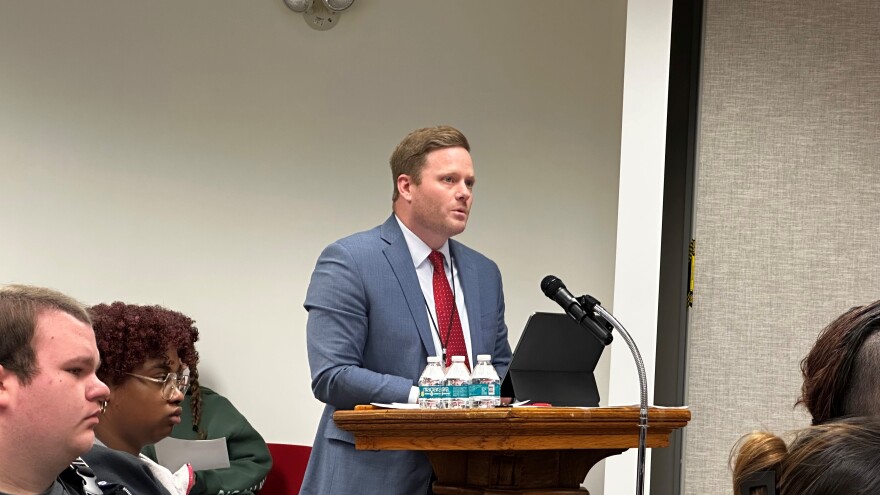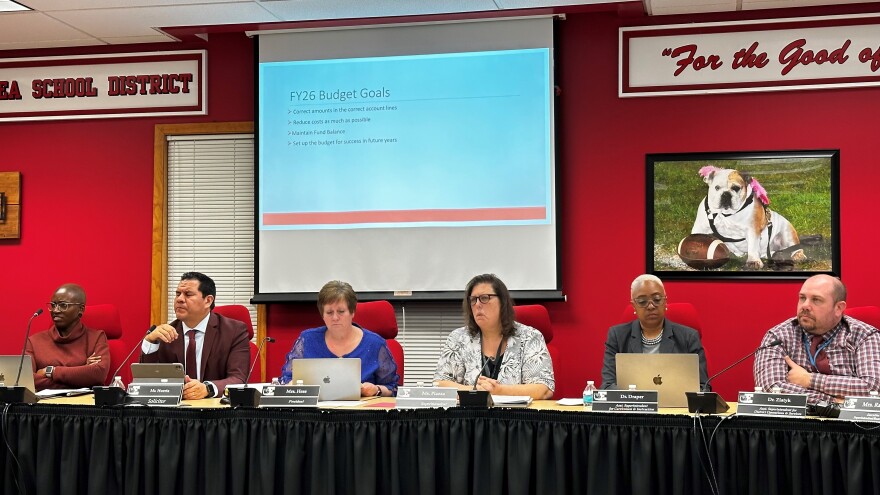EASTON, Pa. — Easton Area School District has projected deficit of more than $7 million for the 2026 fiscal year that could lead to tax increases and cost-cutting measures.
In a budget presentation at Tuesday’s school board meeting, EASD Chief Financial Officer Jack Trent showed a projected total revenue of $212,545,129 and expenditures of $219,999,086.
To close the gap, the board may consider increasing the tax levy, now set at 2%.Easton Area School Board budget presentation
Projected local, state and federal revenue stood at $205,545,129.
All told, the deficit sits at $7,444,957. With a rapidly depleting fund balance and few chances to increase revenue substantially, the district has just two months to make the ends meet.
To close the gap, the board may consider increasing the tax levy, now set at 2%.
Further suggestions included adding a 1.5% tax increase to account for capital projects or using Tax Increment Financing of $7 million that will become available in fiscal year 2026.
Also, exploring a health insurance buyout for eligible employees, cutting back on projects, evaluating staffing needs, working with an insurance broker to cut costs and looking into asset sales to increase the fund balance.
Looking at a real estate tax analysis, Trent showed each percent increase on taxes would yield $1,159,764 for the district.
But that might not be enough to bridge the budget gap and maintain the fund balance — an issue that could become even larger in the future.
$17 million drop in three years
The fund balance is a particular hot-button issue, as the district has had to rely on it over the past few years to bridge budget gaps.
An audited end-of-year balance in fiscal year 2020 showed a $45,824,972; 2021 had $42,951,197; 2022 had $38,010,012; and 2023, the last completed audit year, showed $28,808,825 in the fund balance — a $17 million drop in three years.

“The fund balance is very important," Trent said. "It's the difference between our assets and our liabilities, it gives us a cushion, gives us a surplus if we need it.
"And then sets up the budget for success in future years, which, again, is important to everyone.
"But we need to look at fiscal year ‘27 right now, then you look at fiscal year ’28, fiscal year ’29, especially as we move forward with the capital project for the new high school,” Trent said.
Local revenues, including taxes, interest on investments, rentals, athletic events, tuition and miscellaneous revenue led to a projected revenue of $141,916,524, based on a 2% increase.
State revenues, including state aid, grants, and state shares, will bring in $59,792,127, while federal funding via ESSA, such as Title I, II, III, and IV, will amount to about $3,704,335, with an assumption the district will get about 80% of its anticipated funds.
Revenues and expenditures
Additional revenue will come through Tax Increment Financing — with a projected $7 million for fiscal year 2026.
That's where local taxing bodies make a joint investment in the development or redevelopment of an area, opting to reinvest and leverage short-term gains in order to bring about larger gains in the future.
“We can maybe make cuts to reduce the impact on the taxpayers, but we can't make enough cuts unless we decimate a lot of things to bring us back up to where we once were."Easton Area School Board member Michael Simonetta
Salaries, as is standard, are the bulk of the budget, coming in at $83,851,021. Benefits amounted to $57,783,305.
Purchased services — services provided by non-district personnel, professional and technical services, and property services — were listed at $45,901,695 and supplies, property, and bonds at $32,463,075.
Board member Michael Simonetta called attention to the fund balance near the end of the presentation.
Simonetta said it had hovered around $18 million —not counting capital projects — in 2012, when the district was able to renovate five elementary schools, build two new schools and a stadium and reinstate some programming, including full-day kindergarten, all without raising taxes.
He said since fiscal year 2021, the district had used $24.4 million of the reserves to balance budgets. With estimates for the as-yet-unaudited years, Simonetta said the total amount taken out of the fund balance hovers around $42 million.
“We can maybe make cuts to reduce the impact on the taxpayers, but we can't make enough cuts unless we decimate a lot of things to bring us back up to where we once were,” Simonetta said.
'We have two months'
Simonetta said something had to be done in the coming two months before the preliminary budget vote occurs.
Trent agreed that protecting the fund balance was a priority, and emphasized it would be unlikely to increase revenue, so trimming expenditures would be the likely path forward.
“And we are currently looking at ways coming in the next year, there may be tougher measures that may need to be made that are going to require board action and approval,” Trent said.

“So if it comes down to getting a fund balance into a place where we're healthy, then that may be where it's at. But we have two months" to do it.
"And I think with what we have in motion, we are going to shave money off of those expenditures. It will be brought down.
"The gap will not be $7 million, we know that, but we don't have any of those completely set in place yet.”
“Certainly there are still some spaces in which we need to investigate and look at, but there are some fixed costs in there as well."Easton Area Schools Superintendent Tracy Piazza
Board member Brian Snyder, acknowledging salaries and benefits could not be touched, suggested Trent look into the rest of the budget for potential cost savings.
Superintendent Tracy Piazza clarified that some of those allocations consisted of contracts with the local library, Northampton Community College, the Intermediate Unit, and other entities, and can't be cut.
“Certainly there are still some spaces in which we need to investigate and look at, but there are some fixed costs in there as well,” Piazza said.
The superintendent also touched on federal funding.
“We think that they will be level set for next year," Piazza said.
"We've also been given advanced notice that that will likely not be the case for the following year.
"That following year we may see lesser funds coming into districts. We will still have some funding that comes into the district for the next several years, but we cannot count on all those dollars just yet.”
Trent said the next steps in the budget process will include reviews with the finance committee, meetings with board members, meetings with staff to finalize their budgets, and a final budget presentation by April or May.
The budget is intended to be adopted in May 2025.


